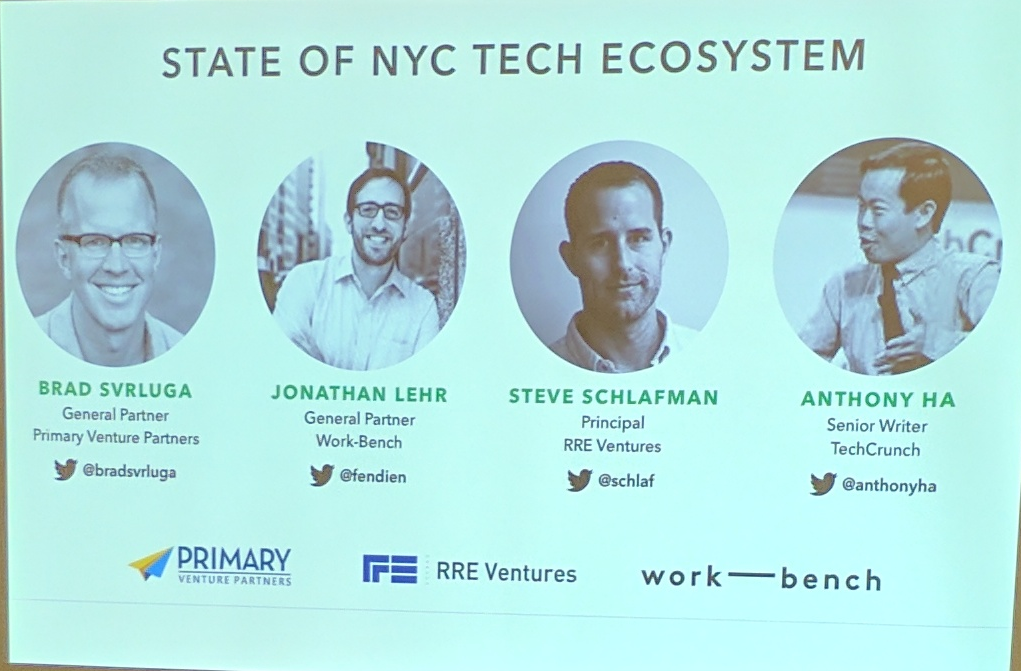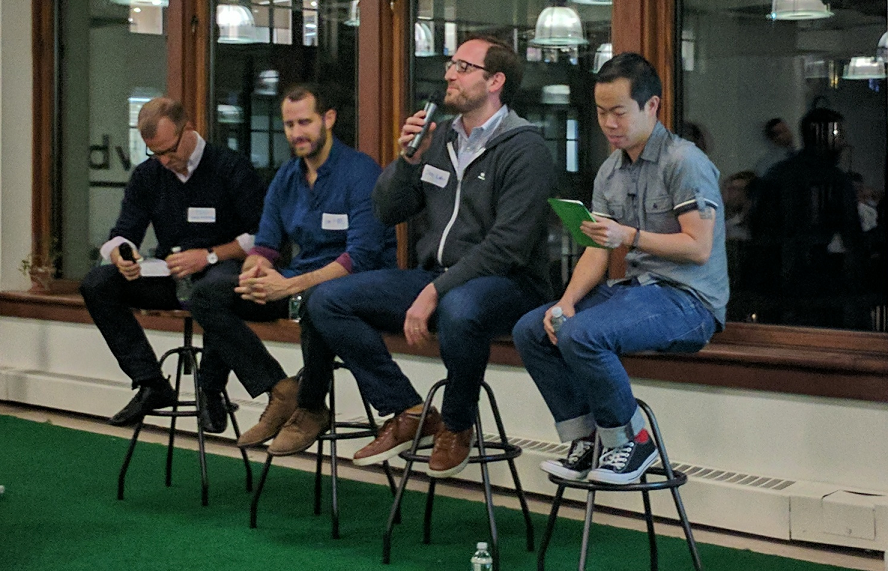
If someone today were to suggest the New York City’s tech scene was little more than a suburb of Boston’s, they would be laughed out of the room, and rightly so. But that was the conversation that the skeptics were having not so long ago recalled Brad Svrluga, general partner at Primary VC. He, along with Steve Schlafman, principal at RRE Ventures and Jonathan Lehr, managing director at Work-Bench, gathered last Tuesday at Work-Bench’s offices to discussed the state of the New York City technology ecosystem; its progress, problems and promises. The discussion, moderated by senior TechCrunch writer Anthony Ha, began with a question on the biggest differences from 5 year ago.
Steve, who at the time was a principal at one of the original New York seed funds Lerer Ventures, noted that there is a lot less FOMO and more patience amongst investors. “It was the height of second wave with Twitter, Tumblr and Foursquare,” he recalled. “If you looked at the capital base, seed funds were just getting started. Now there’s a lot more maturity on investor and operator side. Not to say it was manic, but now it’s more carefully considered.” Brad saw it a bit differently, “it was manic, it was insecure but it was real.” But he didn’t see renewed caution around funding as a major disadvantage “it’s harder to raise that incremental dollar but not to build a company.”
Jonathon, who came from IT at Morgan Stanley and founded Work-Bench, an enterprise tech fund and coworking space, reflected on the growth of the community in general. Johnathon started the NY Enterprise Technology Meetup 5 year ago and has seen it grown to now over 5000 members. Brad pointed out that the departure of individuals like Johnathan from the finance industry is part of what spurred the second wave of NY tech. “The financial crisis was the best thing to happen to tech scene. Tech became cool. Now there is a legitimate swagger,” Brad remembered “there was a discussion that ‘is New York a suburb of the Boston tech ecosystem?’ Now that seems absurd, but people said that.”

Yet despite increasing draw tech has had in recent years, the panel agreed that the shallow talent pool has hampered the growth of the ecosystem. “the biggest void is in marketing and operations specific to large software companies” claimed Steve. “Companies are raising $40 or $50 million dollars and they need to be able to put that money to work.” He described the situation of a Lerer Ventures portfolio company that expanded their operations to the west coast. “They hired an SVP of marketing there and they can just pluck talent from big companies like oracle.” Brad saw the problem as more deep seated; “we don’t have that multigenerational talent that the valley does” and Jonathon echoed the sentiment “one thing we’re missing is enterprise exits.” But Brad identified the problem even further up the pipeline. “We will suffer as long as we don’t have a MIT or Stanford. NYU and Columbia are not even close; the quality of their computer science and engineering departments aren’t even close.” He went on “if I were mayor for a day, I would make the Cornell tech project twice as big, twice as soon.”
Bottlenecks aside, everyone agreed strong tailwinds, both general and specific to New York, would drive the growth of the ecosystem in the years to come. For one, the maturation of both tech infrastructure and business model will help spur the creation of new companies. “No one questions SaaS or Cloud these days” observed Brad. “They start building at the business logic level of the stack. Now there’s a premium on UX design.” He argued that since companies no longer worry about putting their data in the cloud, industries that we’re previously hesitant to adopt technology solution are now more open. “You can see verticalization; salesforce had to be for everyone, now you can target niches and focus on customer context.” One advantage of this; “New York City leads in potential customer’s way, way more than anyone else.” Johnathon reiterated the proximity advantage enterprise software companies have in New York. “There’s now a propensity to buy software from early stage companies. They buy less software buy in west, they build it themselves or use open source. Finance, they buy tons and tons of tech to stay ahead of curve.” However, he also noted constraints of that model. “You have to build alongside the companies. You have to talk about ideas and understand their pain points.”
Even more fundamentally, purchasing practices have changed because the purchasers have changed. “Millennials grown up on the web and then go into industry and see broken processes,” Steve observed. “They see unnecessary paper work and old programs in Excel. People that are living that pain point start asking ‘why isn’t that in cloud?’ The generation that has grown up on the web has the impetus to start these companies and solve these problems.” Brad also discussed a difference in receptivity to technology. “When you were trying to sell in the 90s, you were selling to people who started in 70s. Even senior management, who might be 45 years old, probably sent their first email in college; that changes everything.” He elaborated, “what we looking for is what industries weren’t touched by the first wave of this, who is just becoming web enabled?”
All in all, the discussion gave an honest, self-critical, but hopeful evaluation of the city and community that we are all a part of. In light of the tremendous progress of the last five years, and problems that will be face over the next, the unmet potential for the ecosystem was undeniable. Steve concluded “in NY, we’re still early days, there’s a lot of room to grow.”



